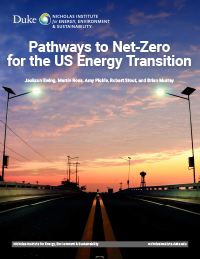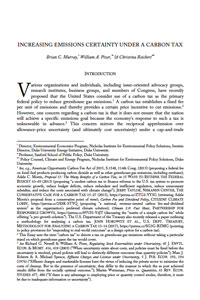Publications
Planning for Growing Electricity Demand During an Era of Uncertain Renewables and Climate Policy
Electricity demand growth has accelerated significantly, a trend that is expected to continue for at least the next 5 to 10 years and is driven by new technologies such as data centers and the expansion of the manufacturing and industrial base in the United States. This analysis uses a variety of integrated resource plans from utilities and other groups to estimate how overall electricity demand may change over the next decade in several scenarios.
Projecting Electricity-Sector Investments Under the Inflation Reduction Act: New Cost Assumptions and Interactions with EPA’s Greenhouse Gas Proposal
Energy Pathways USA, an initiative of the Nicholas Institute for Energy, Environment & Sustainability at Duke University, has released a report that offers new insights into US energy transition investments. This report comprehensively models the intersecting effects of the Inflation Reduction Act, clean electricity development cost increases, and the impacts of proposed US Environmental Protection Agency greenhouse gas regulations for fossil fuels.
Coalition Stability in PJM: Exploring the Consequences of State Defection from the Wholesale Market
Using a simulation tool, the authors investigate the effects created by a US state defecting from the wholesale electricity market in an organized electric grid on the states that remain in the coalition. The report finds that if a net-importing state defects, the remaining states’ producers are worse off and the remaining states’ consumers are better off. The opposite effect takes hold if the defecting state is a net-exporter. Furthermore, the authors find evidence that defection impacts the remaining states’ climate initiatives.
Pathways to Net-Zero for the US Energy Transition
What will it take to achieve a net-zero carbon emissions footprint for the US economy by 2050? This report from Energy Pathways USA helps strengthen the evidence base on what will be required for a robust US energy transition and elucidates key barriers and opportunities for reaching net-zero goals. The report also outlines future areas of focus for Energy Pathways USA, a Duke-based project that accelerates progress towards a net-zero carbon future by developing workable solutions with corporate partners across multiple key industries.
Automated Extraction of Energy Systems Information from Remotely Sensed Data: A Review and Analysis
High-quality energy systems information is crucial for energy systems research, modeling, and decision-making. Unfortunately, actionable information about energy systems is often of limited availability, incomplete, or only accessible for a substantial fee or through a non-disclosure agreement. This systematic review explores remote sensing and machine learning for energy data extraction.
Incentivizing the Reduction of Pollution at U.S. Dairies
This article examines the intricacies of environmental credit generation from concentrated animal feeding operation (CAFO) farm systems. This article describes the stacking problem and explores possible solutions, such as temporal constraints on credit issuance and discounting credits to account for additionality problems.
Effects of Technology Assumptions on US Power Sector Capacity, Generation and Emissions Projections: Results from the EMF 32 Model Intercomparison Project
This article is one of two syntheses in a special issue in the journal Energy Economics on the EMF 32 study, a major modeling study of the electric power sector’s emissions in various policy intervention scenarios. This article focuses on the effects of technology and market assumptions with projections out to 2050. A total of 15 models contributed projections based on a set of standardized scenarios. The scenarios include a range of assumptions about the price of natural gas, costs of end-use energy efficiency, retirements of nuclear power, the cost of renewable electricity, and overall electricity demand. The range of models and scenarios represent similarities and differences across a broad spectrum of analytical methods.
The EMF 32 Study on Technology and Climate Policy Strategies for Greenhouse Gas Reductions in the U.S. Electric Power Sector: An Overview
This introduction to a special issue of Energy Economics presents the key findings of Energy Modeling Forum Model Inter-comparison Project Number 32 (EMF 32) entitled “The EMF 32 Study on Technology and Climate Policy Strategies for Greenhouse Gas Reductions in the U.S. Electric Power Sector.” This study focused on the development and cross-model comparison of results from U.S. climate policy intervention scenarios focusing on policy strategies for achieving greenhouse gas emission reductions in the electric power sector and the sensitivity of emissions and economic results to changes in technology and market assumptions. This overview article describes the motivation for the EMF 32 study, identifies the models used in the study, describes the study's scope and design, and reviews insights in the special issue's articles. A related article focuses on the effects of technology and market assumptions with projections out to 2050.
Increasing Emissions Certainty under a Carbon Tax
Should the United States consider use of a carbon tax as the primary federal policy to reduce greenhouse gas emissions? A carbon tax establishes a fixed fee per unit of emissions and thereby provides a certain price incentive to cut emissions—but it does not ensure that the nation will achieve a specific emissions goal because the economy’s response to the tax is unknown in advance. Ultimately, there is an underlying tradeoff between certainty about emissions and certainty about prices and costs. Mechanisms that balance emissions and cost uncertainty can be viewed as a way to structure a more careful compromise between cost concerns and environmental interests. Under a carbon tax, mechanisms that can increase mitigation action may allow environmental constituencies to agree to what they may view as an environmentally risky tax with the assurance that further steps will be taken should emissions become too high. This symposium essay in the Harvard Environmental Law Review discusses mechanisms that could increase emissions certainty under a carbon tax.
Resolving the Inherent Uncertainty of Carbon Taxes
This introduction to symposium essays in the Harvard Environmental Law Review describes the role of pricing carbon in contemporary climate change policy (with a summary of experience with carbon tax and cap-and-trade policies around the world) and points out similarities of carbon tax policies and cap-and-trade policies based on the academic literature. But it focuses on how a tax and cap-and-trade schemes differ in terms of their economic and emission outcomes in light of the uncertainty characterizing the markets and economies in which these instruments are used. These differences have potentially important economic, environmental, and political economy implications for U.S. climate change policy. Finally, the article highlights the proposals and key findings of each of the symposium essays, including Increasing Emissions Certainty under a Carbon Tax.










